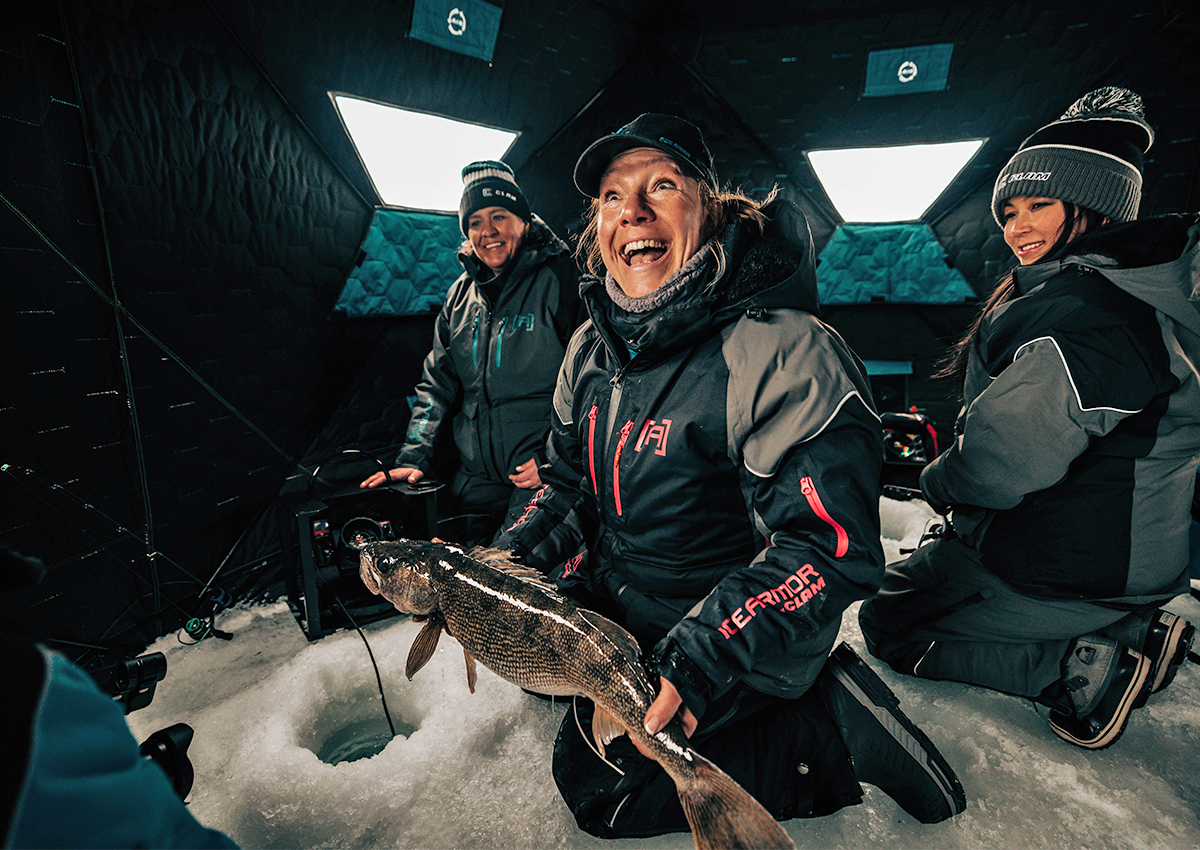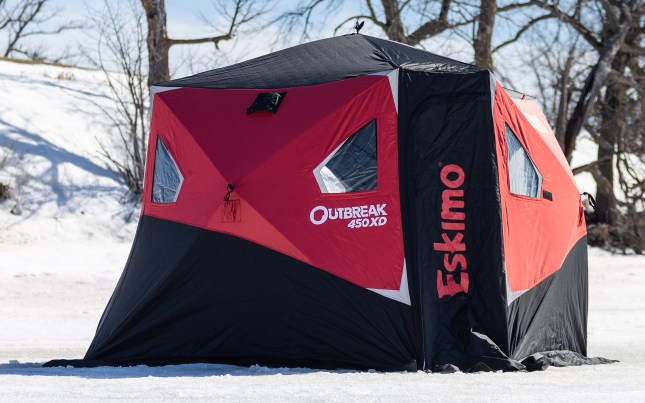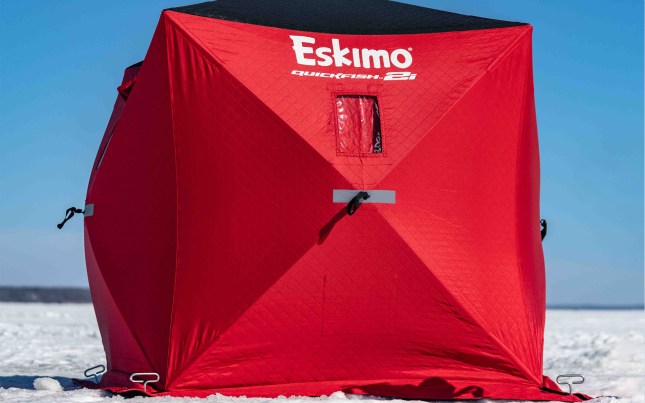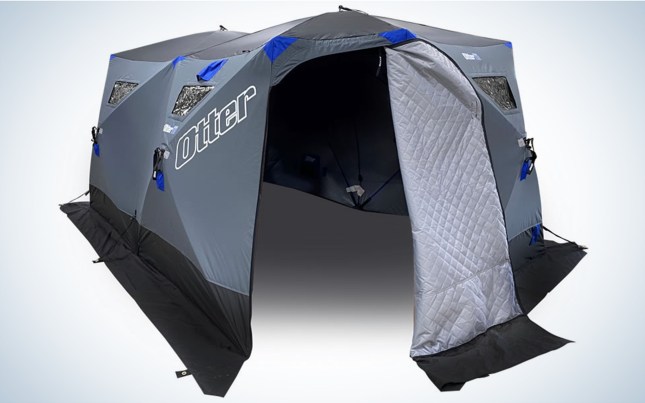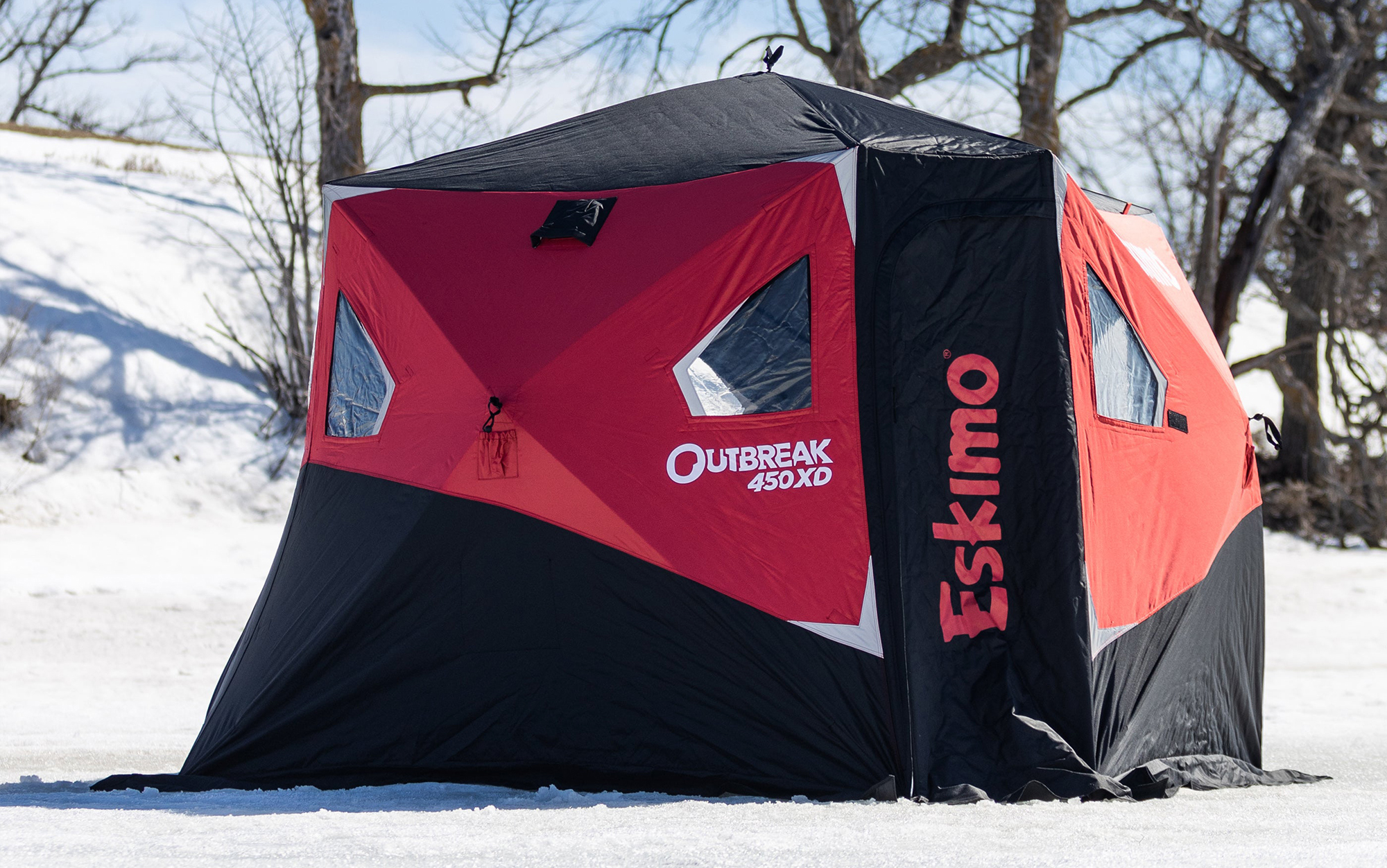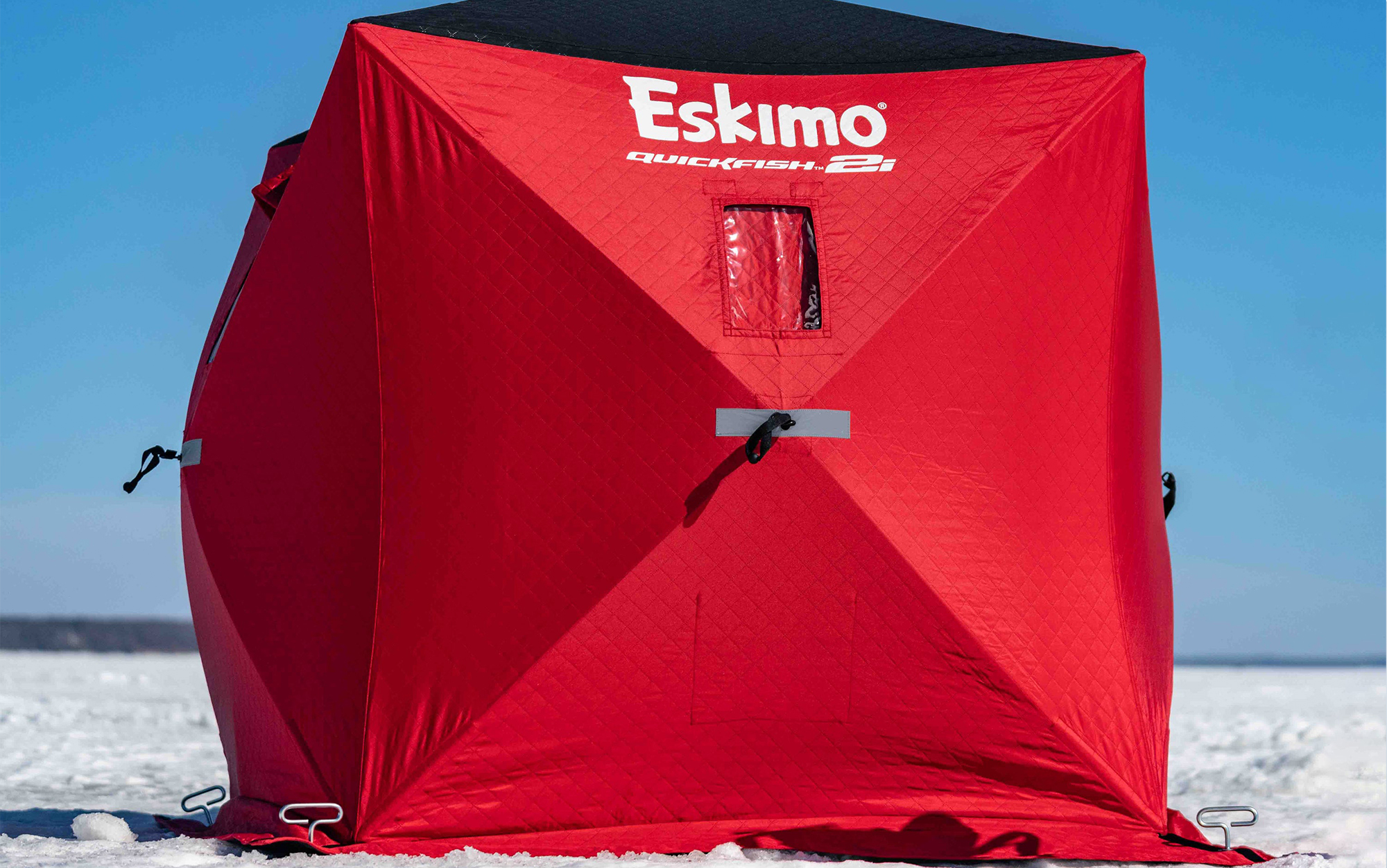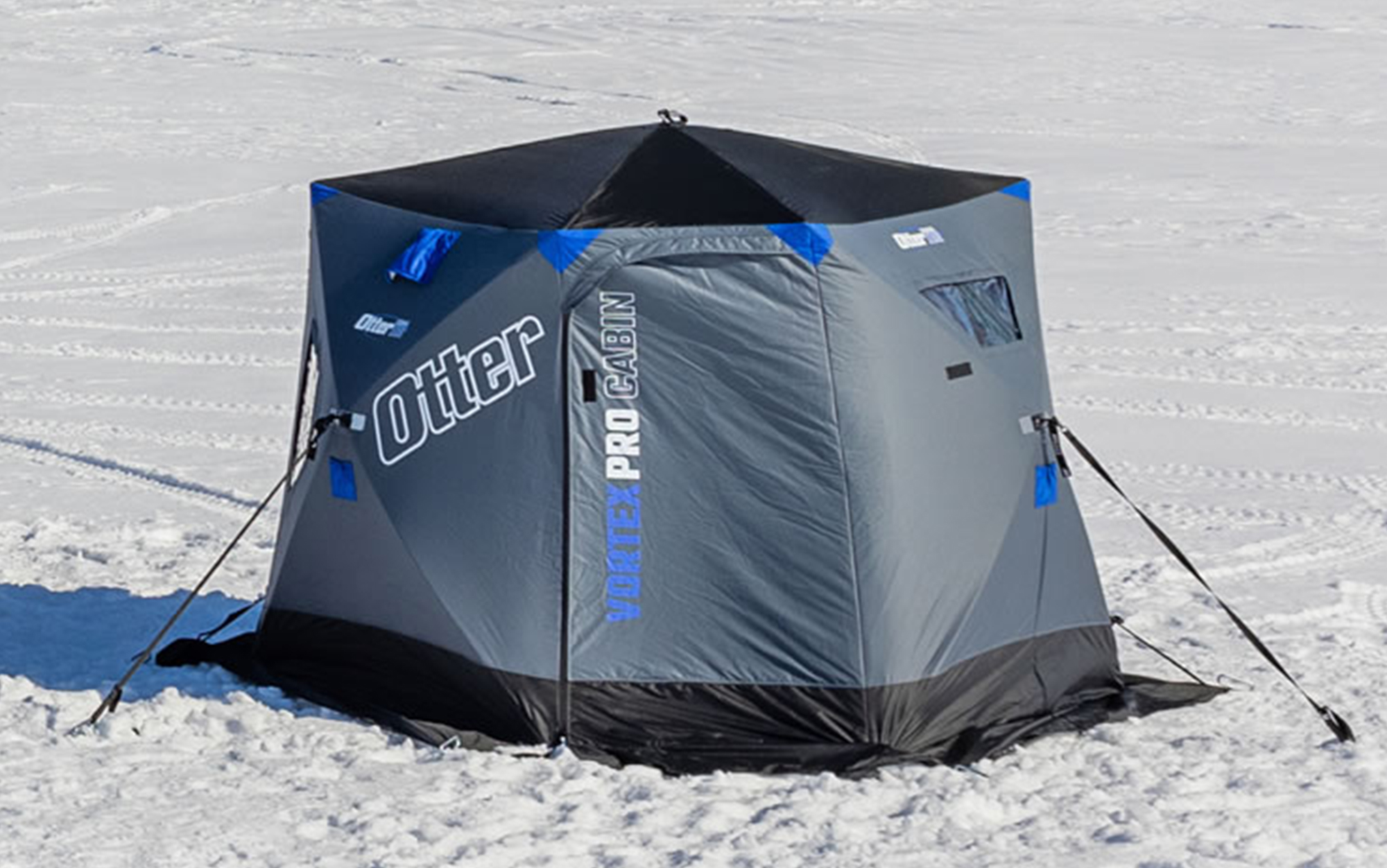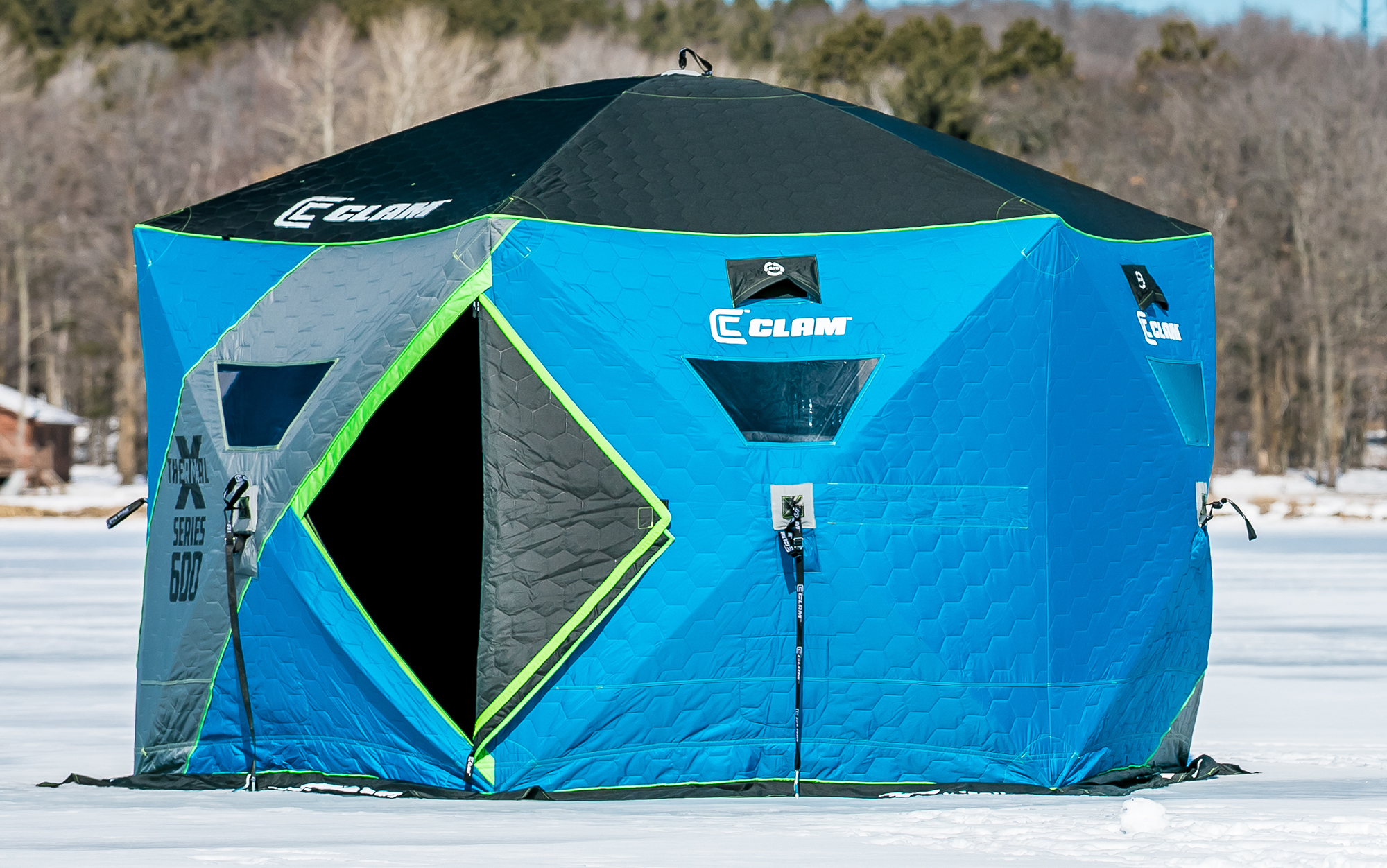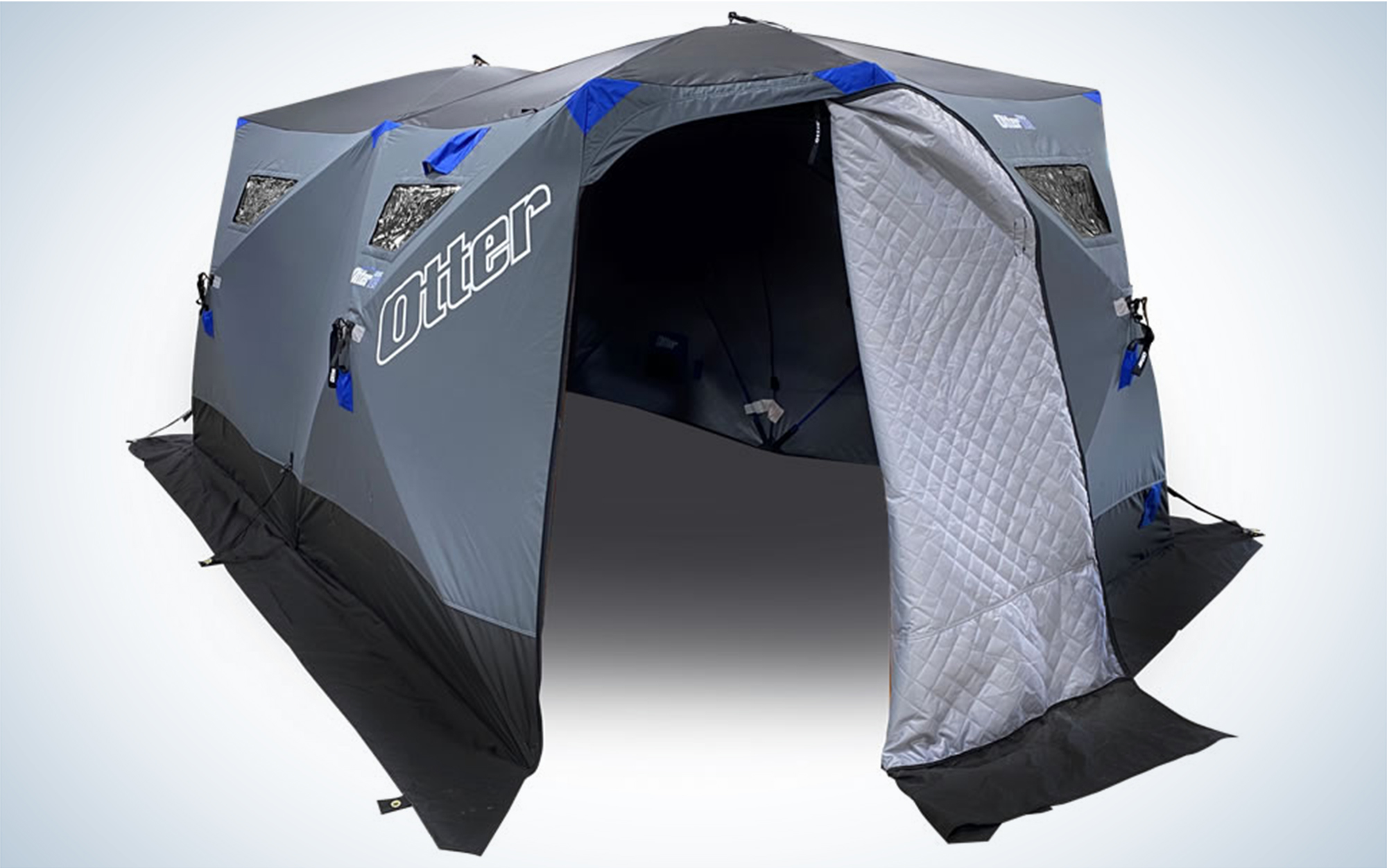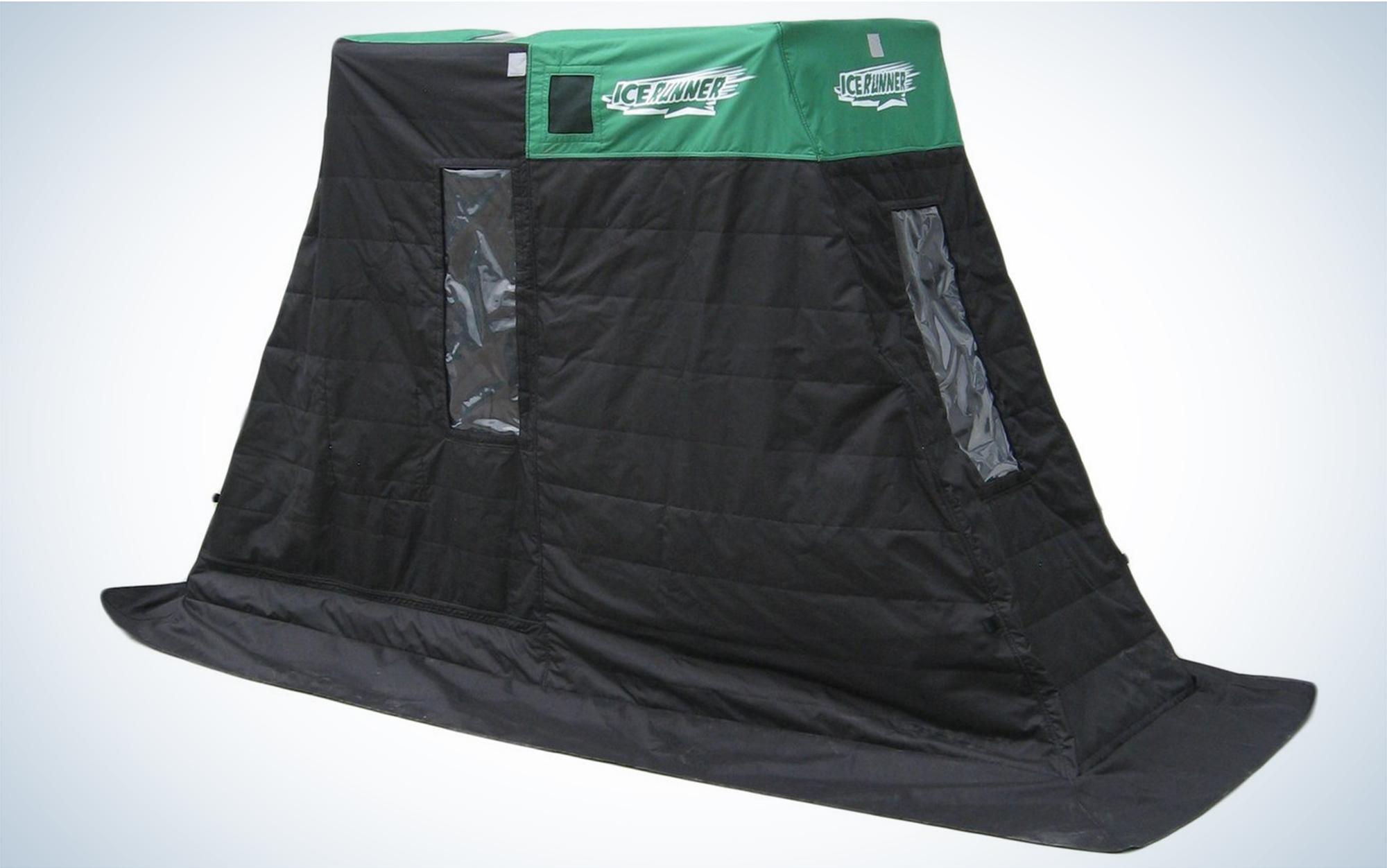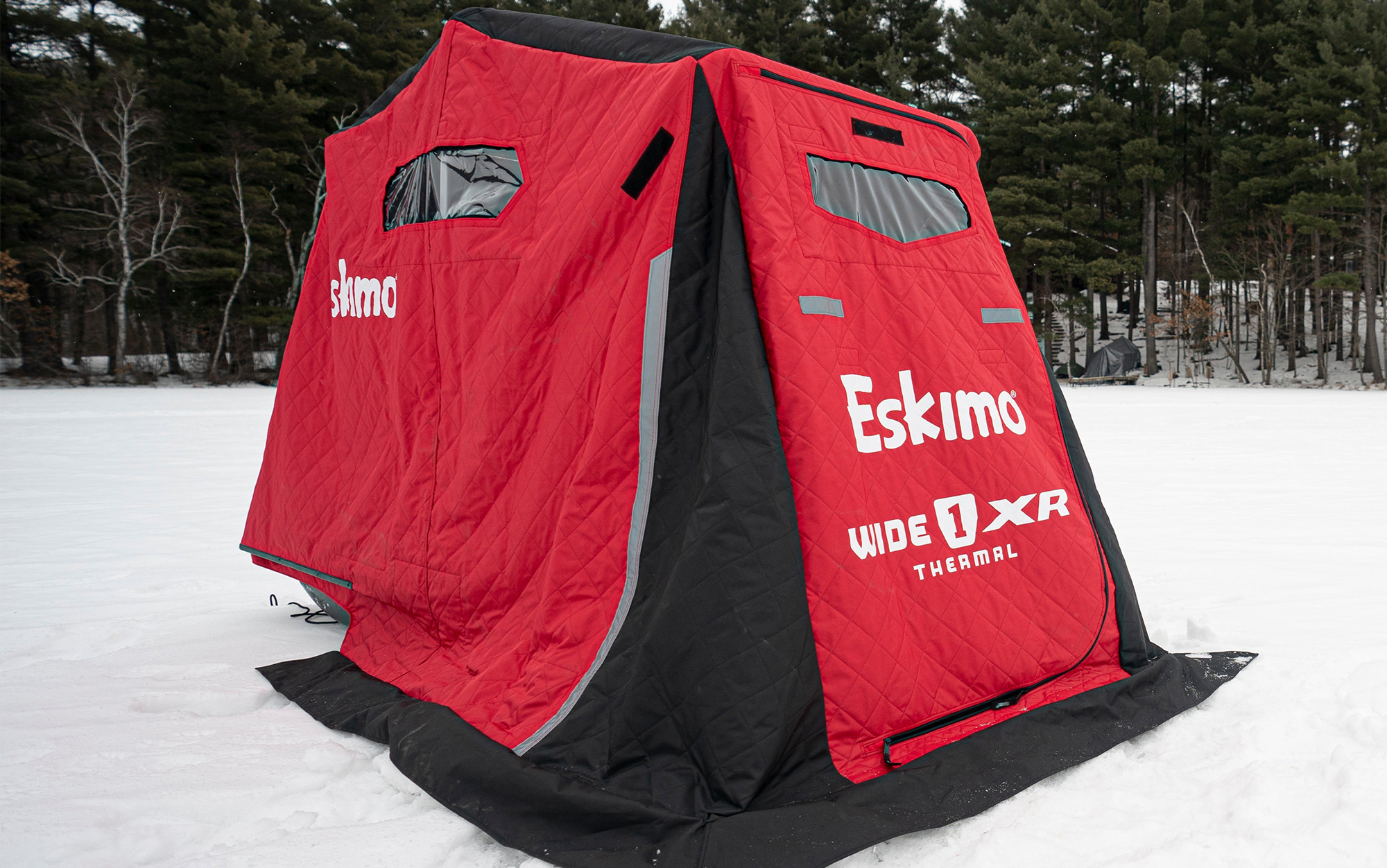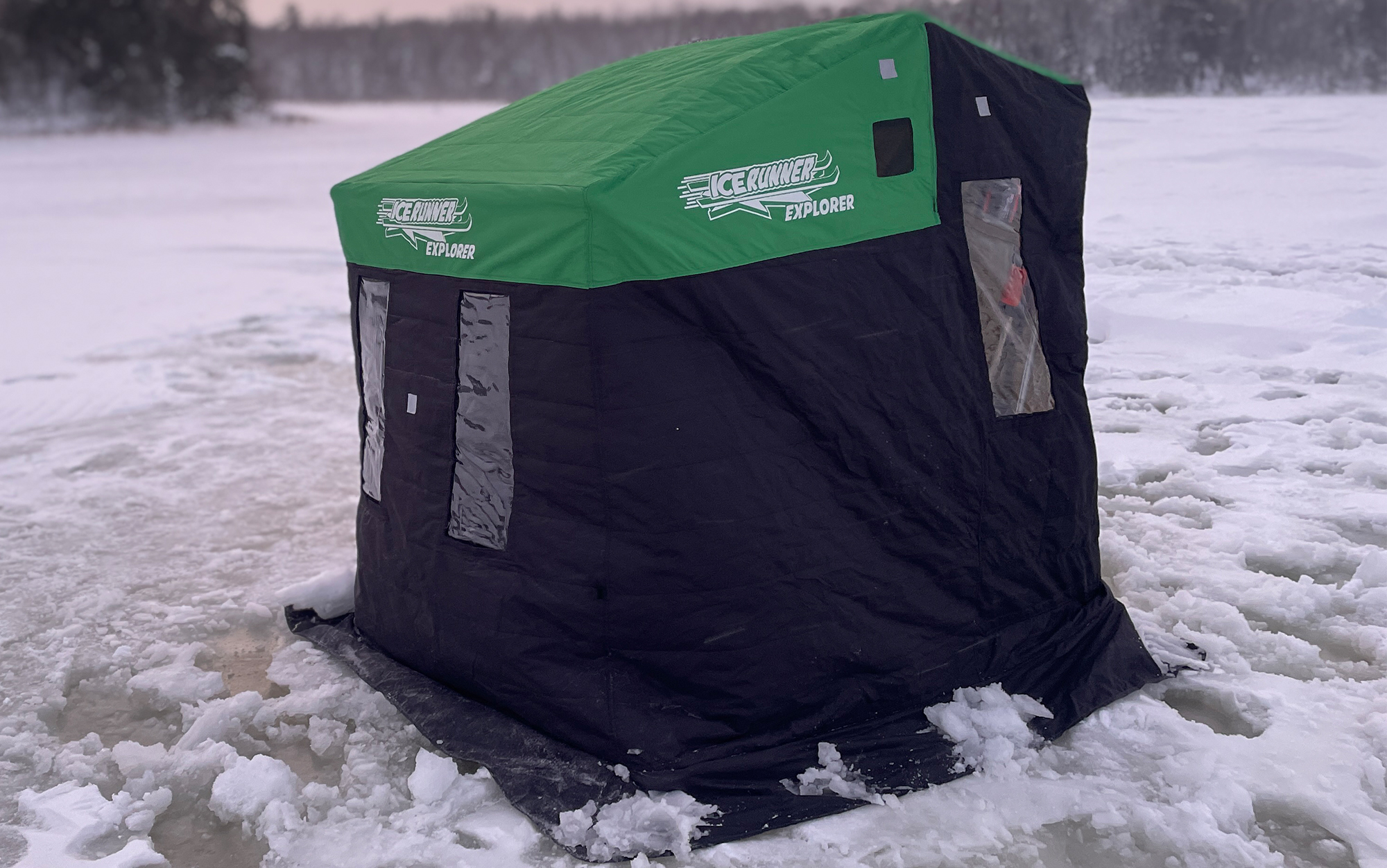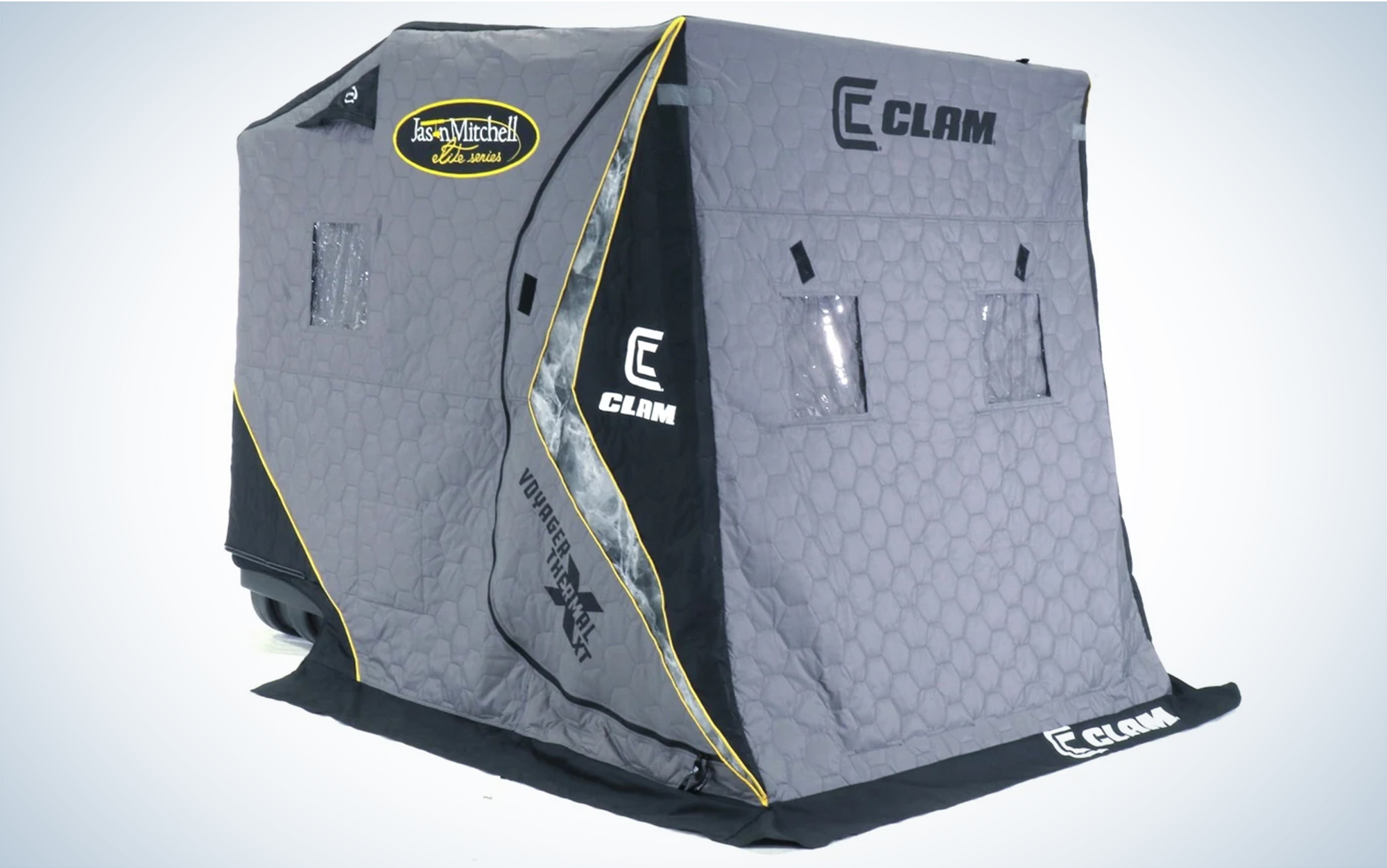We may earn revenue from the products available on this page and participate in affiliate programs. Learn More ›
Once bulky and challenging to transport, today’s ice fishing shelters are light, portable, and highly functional. A quality shelter keeps anglers and their equipment in the game and on fish—even when the snow flies, winds howl, and temperature plummets.
For serious ice anglers, one ice fishing shelter does not do it all. Like our endless collection of outdoor gear, you need at least a couple shelters to match the specific location, target species, and the number of anglers fishing. Brands like Clam, Eskimo, Ice Runner, and Otter Outdoors offer great, problem-solving ice fishing shelter designs—and they seem to get better each year. Here’s a look at the best ice fishing shelters for different use cases.
- Best Overall: Eskimo Outbreak 450XD
- Best Value: Eskimo QuickFish 3i
- Best for Two People: Otter Outdoors Vortex Pro Cabin
- Best for Four to Six People: CLAM X-600 Thermal Hub
- Best for Ice Camping: Otter Outdoors Vortex Pro Monster Lodge
- Lightest One-Person Flip-Over: Ice Runner Ice House Escape
- Roomiest One-Person Flip-Over: Eskimo Wide 1 XR Thermal
- Lightest Two-Person Flip-Over Thermal Shelter: Ice Runner Ice House Explorer
- Most Durable: Jason Mitchell XT Thermal
Testing the Best Portable Ice Fishing Shelters
I’ve been using portable ice fishing shelters for over 25 years. Over that time I’ve used them all: from the first “Fish Trap” designs by the father of modern ice fishing, Dave Genz, subsequent Clam models, to the latest shelters from Eskimo and Otter Outdoors. My ice fishing trips cover several locations including my home state of Minnesota into Michigan, Montana, the Dakotas, and Ontario.
In short, all the shacks I’ve owned have gotten a workout. For this review, I tested the best ice fishing shelters on the lakes of West Central Minnesota, Lake Winnibigoshish, Upper Red Lake, and some hard-to-reach lakes north of Bovey, Minnesota. Now that there’s sufficient ice in the northern part of the state, I’ve had to pull out shelters by hand and shoulder harness, behind a snowmobile or Snowdog, and in the back of the truck. By hand and back power, it’s quite a workout. With a snowmobile, tracked ATV, or Snowdog-style machine, it is somewhat easier. Many of the larger lakes have a series of roads where you can drive the truck, which makes transporting shelters easier.
Along the way, I chased walleyes, pike, trout, crappies/sunfish, and even eelpout. Testing occurred in temperatures that ranged from -10 degrees with -30 windchill to mercury in the low -30s. Helping me in the testing was my longtime fishing buddy, “Big Mike” who towers 6 feet, 3 inches and weighs nearly 300 pounds. I’m 6 feet, 1 inch and 240 pounds—on the larger end of the angler spectrum—so when I refer to elbow room, fishable space, and comfort, our size comes into play.
I also have three kids—ages 10, 15, and 16—who contributed to some of the testing. They allowed me to give an idea of space with one to three kids in tow, and a chocolate lab who loves being on the ice.
Read Next: The Best Ice Fishing Fish Finders
Best Portable Ice Fishing Shelters: Reviews & Recommendations
Best Overall: Eskimo Outbreak 450XD
Key Features
- Assembled Dimensions: 139 x 139 inches
- Ceiling Height: 80 inches
- Weight: 48 pounds
- Space: Three to four people
- 108 x 108 inches of elbow room
- 75 square feet of fishable space
- Removable window panels
- Includes ice anchors
- In-skirt grommets
- Carabiner tie-downs
- MSRP: $529.99
Pros
- Oversized, no-trip door panel that zips down to the ice
- Mesh storage pockets stitched in at the top to prevent gear from slipping out or hanging low
- Gray interior for more ambient light
- Easy to set up and tear down
Cons
- Price is a leap from two to three person hubs
- One year warranty
After a ton of testing, my pick for the best overall ice fishing shelter is the Eskimo Outbreak 450XD. If I had to own just one fish house, this would be it. At 75 square feet, it’s the perfect choice for a couple of fishing buddies and a couple of kids.
The Eskimo Outbreak 450XD accommodated me, my three kids, and the dog on a recent trout fishing trip. We all had plenty of room to place our fold-up chairs and fish two holes each. I could also stand up in the hub and stretch, a super nice feature.
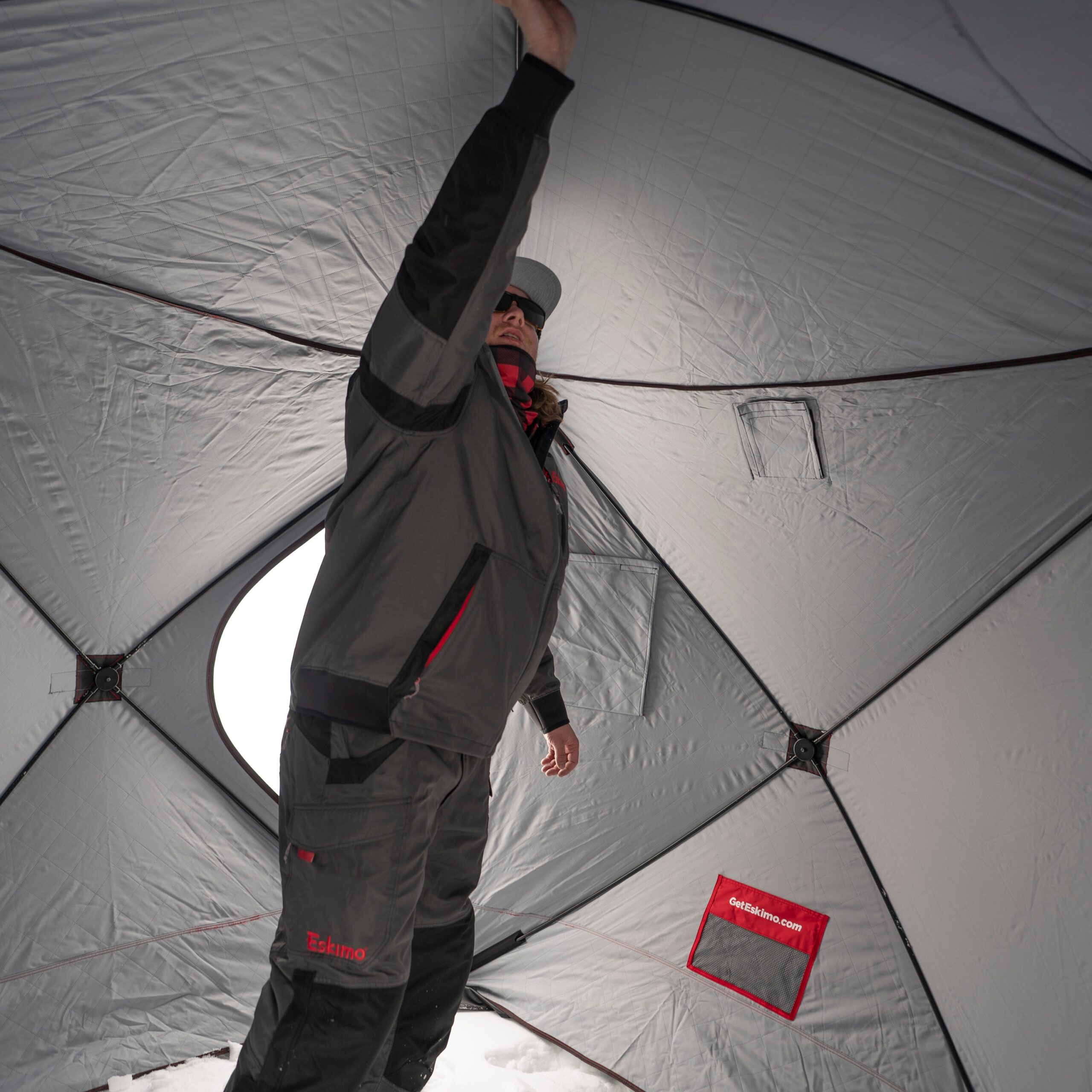
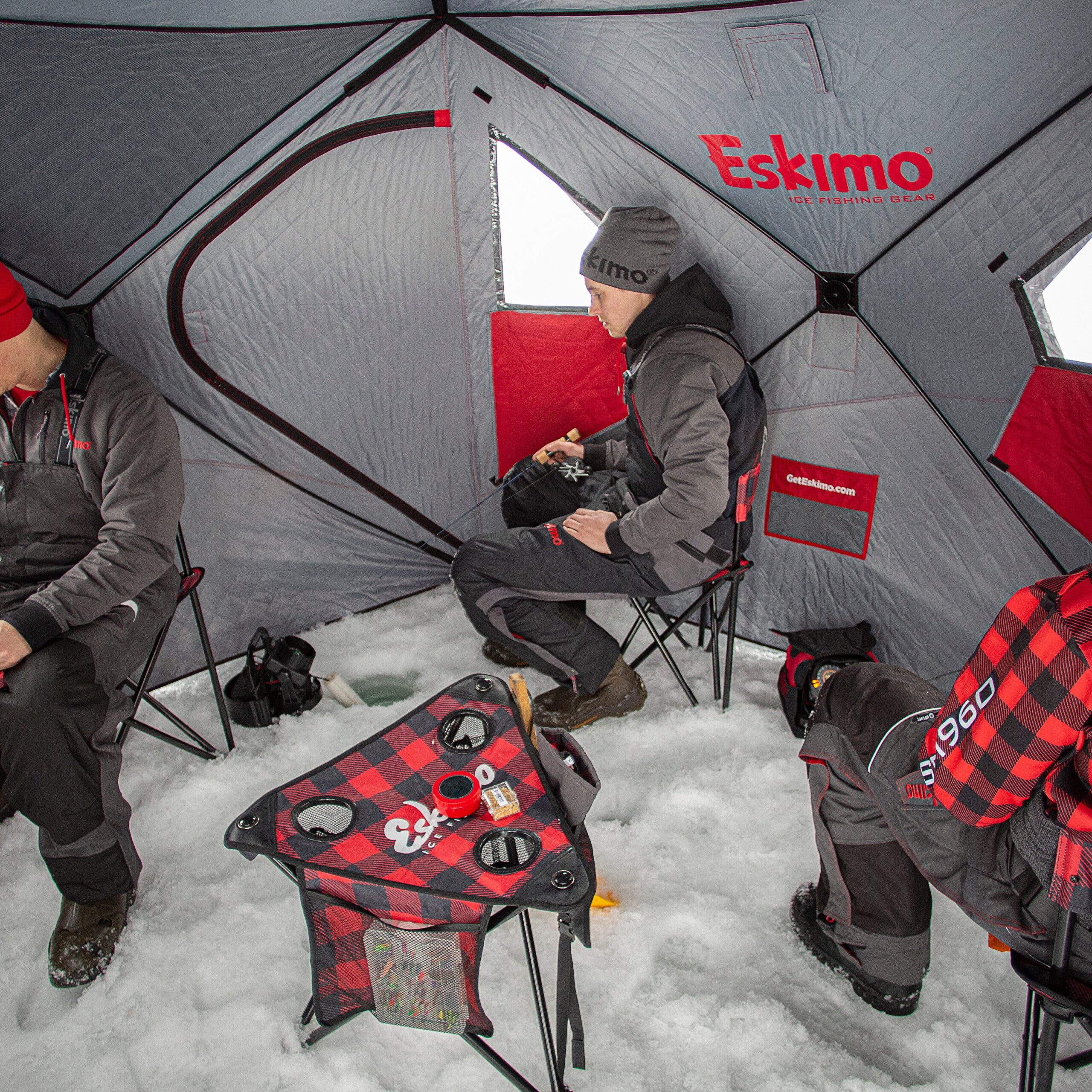
The Eskimo Outbreak 450XD also has room for me, my gear, one kid, and the dog while ice camping. It’s the perfect size for two cots/mattresses, a camp stove, fishing electronics, various-placed holes for fishing a jigging rod and deadstick (as well as rattle reels at night), and all the gear necessary for a weekend trip sans cabin or hard house. Super warm and ventilated, I was cozy as could be. The Eskimo 450XD also set up and tore down easily, even in the wind, and includes a stitched-in instruction sheet inside the bag if you forget. It also works well as a cook shack with a larger hub like the Otter Vortex Monster Lodge or Eskimo Outbreak 850XD for bigger groups of anglers.
Best Value: Eskimo QuickFish 3i
Key Features
- Footprint: 70 x 70 x 80 inches
- Ceiling Height: 80 inches
- Weight: 34 pounds
- Space: Two people, or one adult and two kids
- Collapsed Size: 52 x 10.5 x 10.5 inches folded up in the bag
- 34 square feet of fishable space
- Insulated, quilted design
- Self-tapping ice anchors
- In-skirt ice anchor grommets
- Four windows
- Two vents
- Two mesh storage pockets
- YKK zippers
- MSRP: $349.99
Pros
- Easy to transport by hand, sled, or as a backpack in the bag
- Fits in any vehicle
- Removable window panels for better ventilation
- Affordable
Cons
- Black interior is darker than gray interior shelters
- No full-length doors
- One year warranty
Like its kid brother, the Eskimo QuickFish 2i, the QuickFish 3i can be set up in under a minute and fits easily into the included carrying bag with attached cinch straps. It is constructed of the same durable, Eskimo IQ (Insulated Quilted) material but features an increased 34 square feet of fishable space—enough room for two to three anglers. Plus, it’s lightweight and affordable.
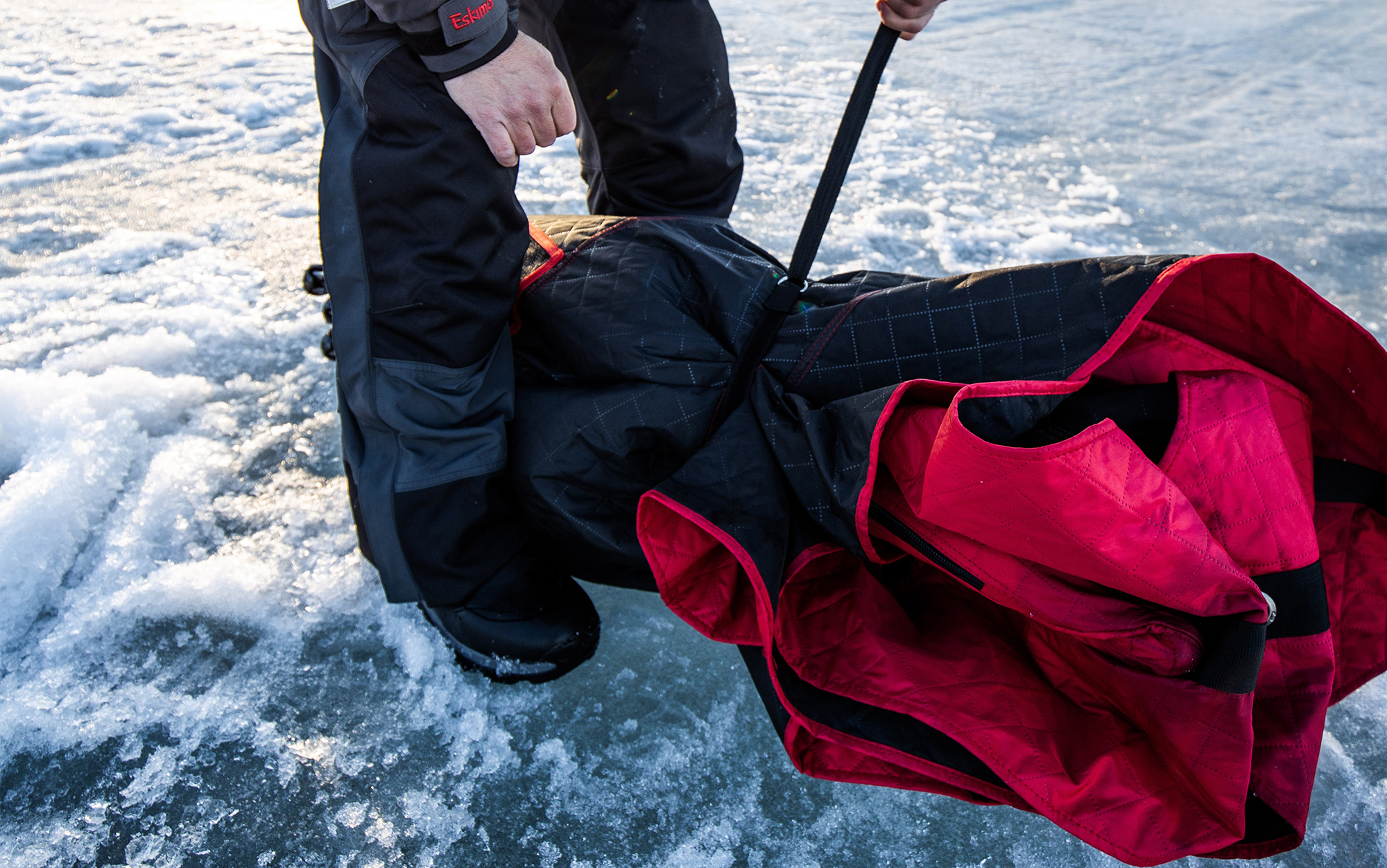
This would be my choice for a basic hub if it was just one kid and me (and probably the dog). Realistically, it’s probably a better shelter for two adult anglers sitting back to back, each fishing a side with 2 or 3 holes. It was easy to carry on my back and walk out on a local lake to fish with my youngest daughter. And it comes at a very affordable price.
Best for Two People: Otter Outdoors Vortex Pro Cabin
Key Features
- Ceiling Height: 75 inches
- Wall Height: 67 inches
- Space: Two to three people
- Weight: 36 pounds
- 48 square feet of fishable space
- THERMALTEC 600 denier triple-layer fabric
- 11mm cobalt poles
- Reinforced corners
- Front dual-coil zippered entry door
- Combination daylight/lookout removable windows with insulated covers
- Interior wide bottom storage pockets and exterior tie-down strap pockets
- Ice-lock anchoring system
- Anchor tie-down kit
- Pocket for safety beacon
- 900 denier oversized carry bag
- MSRP: $399.99
Pros
- Wide base
- Roomy five-sided design
- Interior rod/tool holders
- Interior overhead cargo storage net
- Propane hose port with hook and loop flap
- Fits in any vehicle
- Lots of Otter-exclusive built-in add-ons
- Affordable
Cons
- One-year warranty
A two-person hub shelter should have enough room for each angler to fish two holes, with space to accommodate electronics, tackle, and a portable heater. Insulation will help keep the heat inside, but it should be well-ventilated and breathable to ensure that moisture and condensation can escape. Look for robust zippers or other closures to facilitate getting into and out of the shelter.
I didn’t have the chance to test this shelter personally but it comes on the recommendation of Northern Minnesota ice fishing guide, Brian “Bro” Brosdahl. According to Brosdahl, “The Otter Vortex Pro Cabin is an incredibly high-quality hub at a reasonable price—and it’s super lightweight and easy to transport.” The Vortex Pro Cabin features Otter’s patented THERMALTEC 600 denier triple-layer fabric layer system for durability, warmth, and reduced condensation.
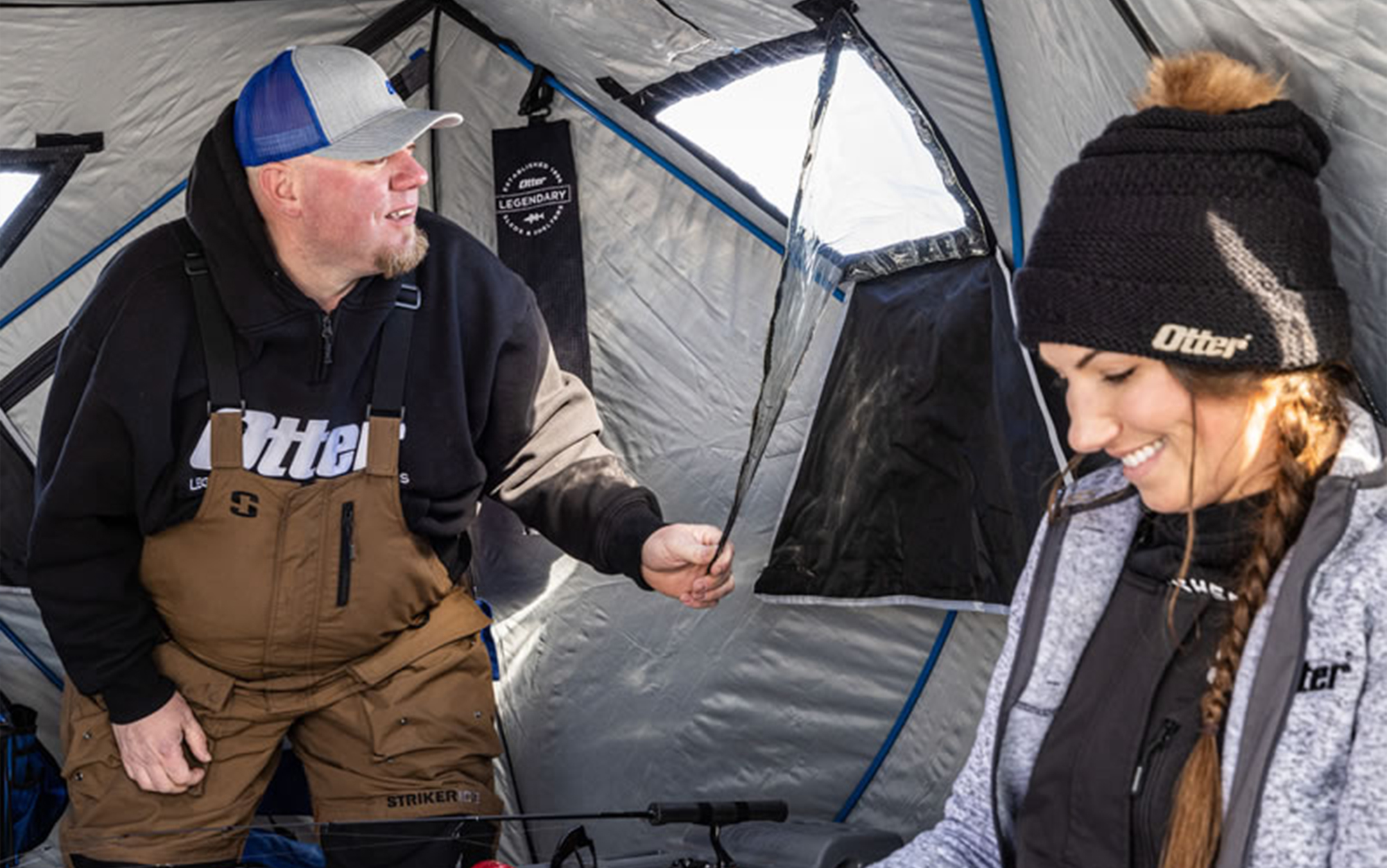
Brosdahl says it has storage for your tackle boxes and enough rod holders to hold your one-two-three punch right on the wall. You also get an overhead storage net for keeping gloves and jackets warm. “I also like the propane hole for running larger tanks; plus it’s got a hook and loop, so you don’t get a draft through it,” he says. “The big, wide door is fantastic for carrying gear in and out.”
He also says the double strap on the ice anchors in the corners allow you to screw it down and then pinch the top tightly, so you don’t get any slack in the house corners. And all the straps fit into the provided storage pocket.
“I really put shacks through the wringer using them every day of the winter, and when it comes to poles, a lot of ’em break over time. Not Otter’s. The other thing: Otter shacks are super warm with 600 denier fabric, a big deal up here in Northern Minnesota where we routinely get sub-zero temperatures. The double-layer of heavier denier also prevents frost build up on the inside, a problem with some shacks,” Brosdahl says.
Best for Four to Six People: Clam X-600 Thermal Hub
Key Features
- Ceiling Height: 90 inches
- Diameter: 11.5 feet
- Weight: 60 pounds
- Space: Four to six people
- Collapsed Size: 75 x 14 x 14 inches
- 94 square feet of fishable space
- Strong 600 total denier fabric (90 grams of insulation per square meter)
- Full thermal skin to retain heat/reduce condensation
- Flex-tested 11mm poles
- Oversized skirt for banking with snow
- Six ice anchor straps and strap pockets
- MSRP: $569.99
Pros
- Designed for windy conditions
- Accepts Clam Lock Plate accessories
- Designed for use with Clam’s heavy-duty removable floor for a slush-free floor
- Three year warranty
Cons
- Price is a leap from three to five person hubs
- Heavy
The Clam X-600 Thermal Hub provides plenty of space for a big group. It is a great choice for those holiday trips when all of your friends and relatives want to go fishing or when you want to use your shelter as a base camp for a multi-day, hard-water adventure. This large, hub-style shelters offer abundant fishable space for larger groups, or allow you to use a portion of the shelter as a field kitchen or even a designated sleeping area equipped with cots and bags.
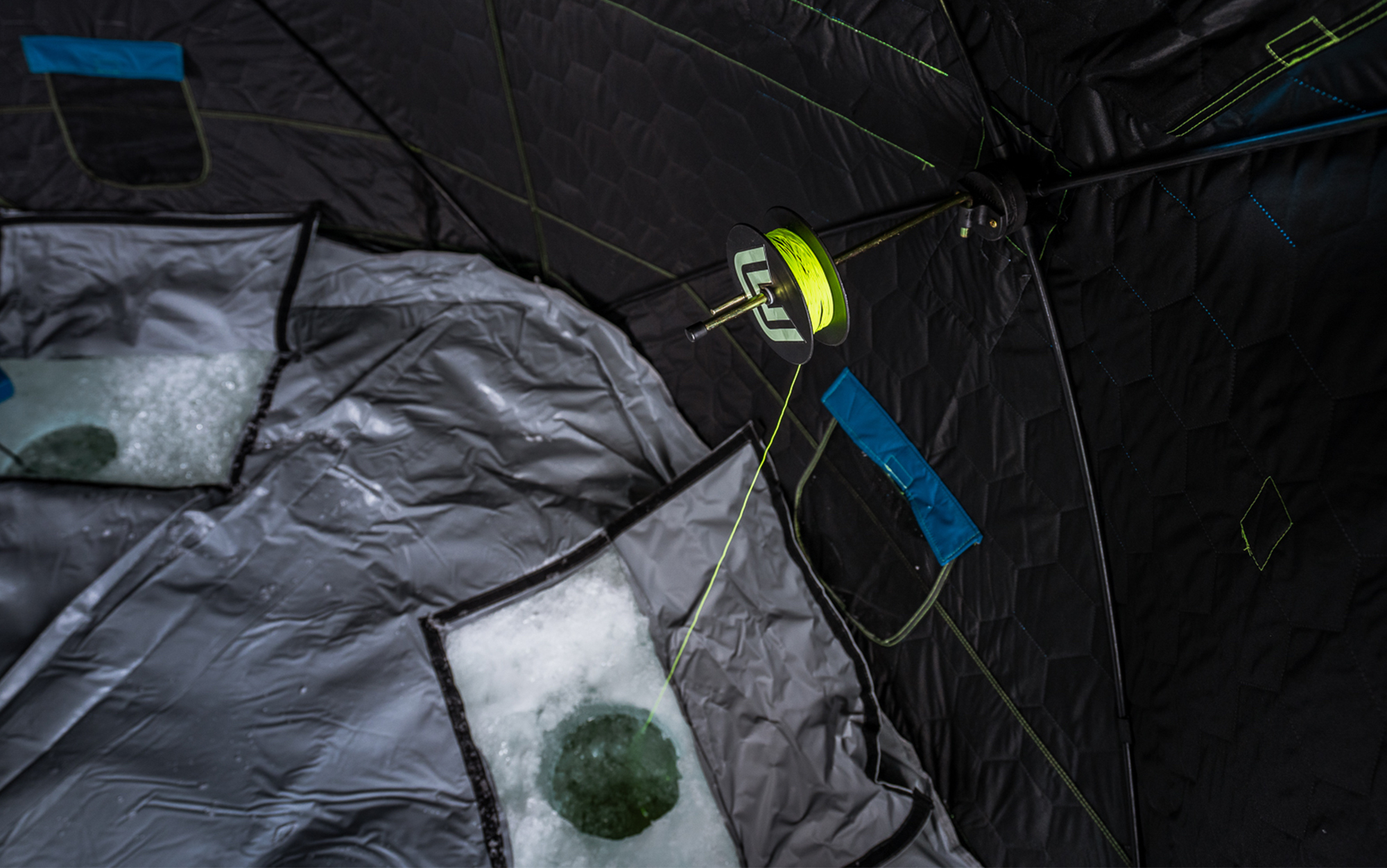
Insulated and well-ventilated, the Clam X-600 shelter offers 94 square feet of interior fishing space, yet weighs only 60 pounds—all qualities to look for in the best ice fishing shelters for a large group.
This is another shelter I didn’t have the chance to test, but took on the recommendation of expert ice angler Pat Kalmerton, who works with young anglers through Take Them Kids Outdoors (TTKO). Suffice to say, he’s used to taking out large groups.
“Heat-pressed seams keep all the insulation in place so it won’t slip or bunch up over time. Secondly, the heavier-duty 11mm poles flex, so they’ll last years. You also have Velcro along the entire perimeter for the insulated floor option, and the corners are well stitched,” he says.
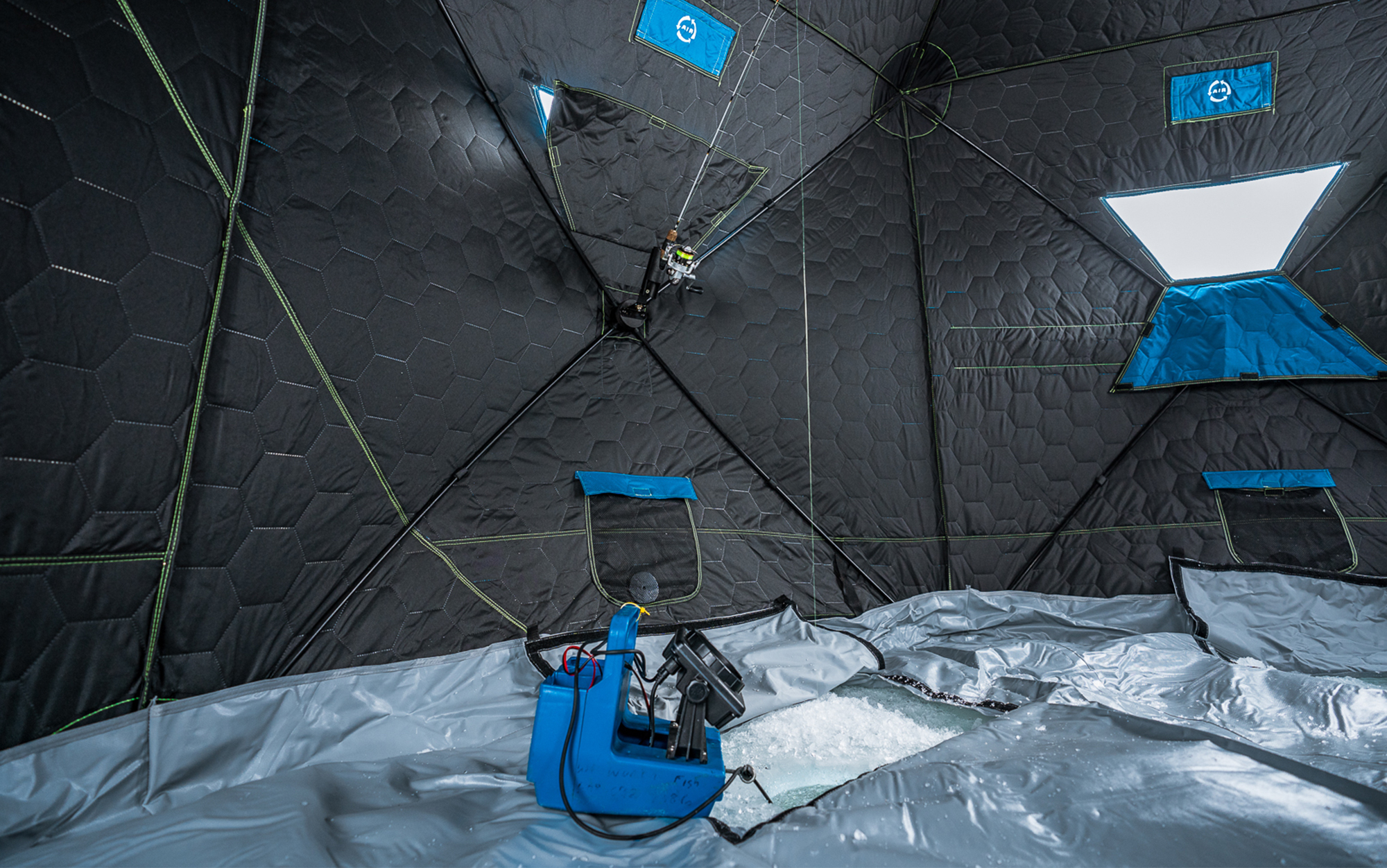
Kalmerton also mentioned the cinch-down anchor straps can withstand strong, Wisconsin winds. He likes that you can add lots of accessories, cup-holders, LED lights, fans, cell phone holders, rod holders, rattle reels, coolers, etc., via Clam Lock Plates. “I’ve had my three kids, a buddy’s two kids, and three adults in it at once with six holes along the walls and one in the center,” says Kalmerton.
His go to setup for the backwaters of the Mississippi River is to put drop-shot rigs on rattle reels in all the corners, and then jig in the middle of the hub. He says once you fire up one or two fish, all the lines go crazy.
Best for Camping: Otter Outdoors Vortex Pro Monster Lodge
Key Features
- Ceiling Height: 79 inches
- Wall Height: 68 inches (over 5-and-a-half-feet)
- Weight: 73 pounds
- 132 square feet of fishable space
- THERMALTEC 600 denier fabric layer system
- Triple-layer shell provides the perfect combo of durability, warmth, and reduced condensation
- Extreme duty 11mm cobalt poles
- Combination daylight/lookout removable TPU windows with insulated covers
- Interior wide bottom storage pockets and exterior tie-down strap pockets
- Ice-lock anchoring system
- Anchor tie-down kit
- HD nylon wind anchor straps w/ adjustable quick-release buckles
- Nylon packing strap with high compression quick-release buckle
- Pocket for safety beacon and flag (beacon must be purchased separately)
- 900 denier oversized carry bag
- MSRP: $799.99
Pros
- Large entry door
- Reinforced corners
- Wide base
- Interior rod and tool holders
- Interior overhead cargo storage net
- Propane hose port with hook and loop flap
Cons
- Heavy
- Only one cinch strap included for packing
- Only one full-size door
- Door pole splintered and required Gorilla tape
- One year warranty
My mission this last fall was to purchase the largest hub-style shelter made. I’m an ice angler who’s always trying to find smarter (and more spacious) ways to ice camp with friends and family. My must-have list includes enough room for cots and an inter-lockable and customizable 1-inch foam exercise-mat style floor over the ice. Sleeping and fishing in a portable shelter through weekend-long forays on the ice can reduce the cost of lodging or hard house rental and provide nighttime fishing action.
My research led me to Otter Outdoors’ Vortex Pro Monster Lodge, which was redesigned for the 2022-2023 ice season. The major difference is a full-size, pole-stabilized door on one end rather than a triangular door you had to crouch through. Featuring an expansive 132 square feet of fishable space, the Vortex Pro Monster Lodge will accommodate six to eight anglers without bunks and gear.
The Vortex Pro Monster Lodge is also easy for one person to set up (simply drill in one corner ice anchor and proceed to pop open the sides and tops). It doesn’t weigh much at 73 pounds; you can transport it in a sled with a harness or in a sled behind a snowmobile or ATV, and easiest is in the back of the truck. Otter’s Monster Lodge has enough room for two to three cots with mattresses. It’d fit even more cots if you purchased bunk-style cots.
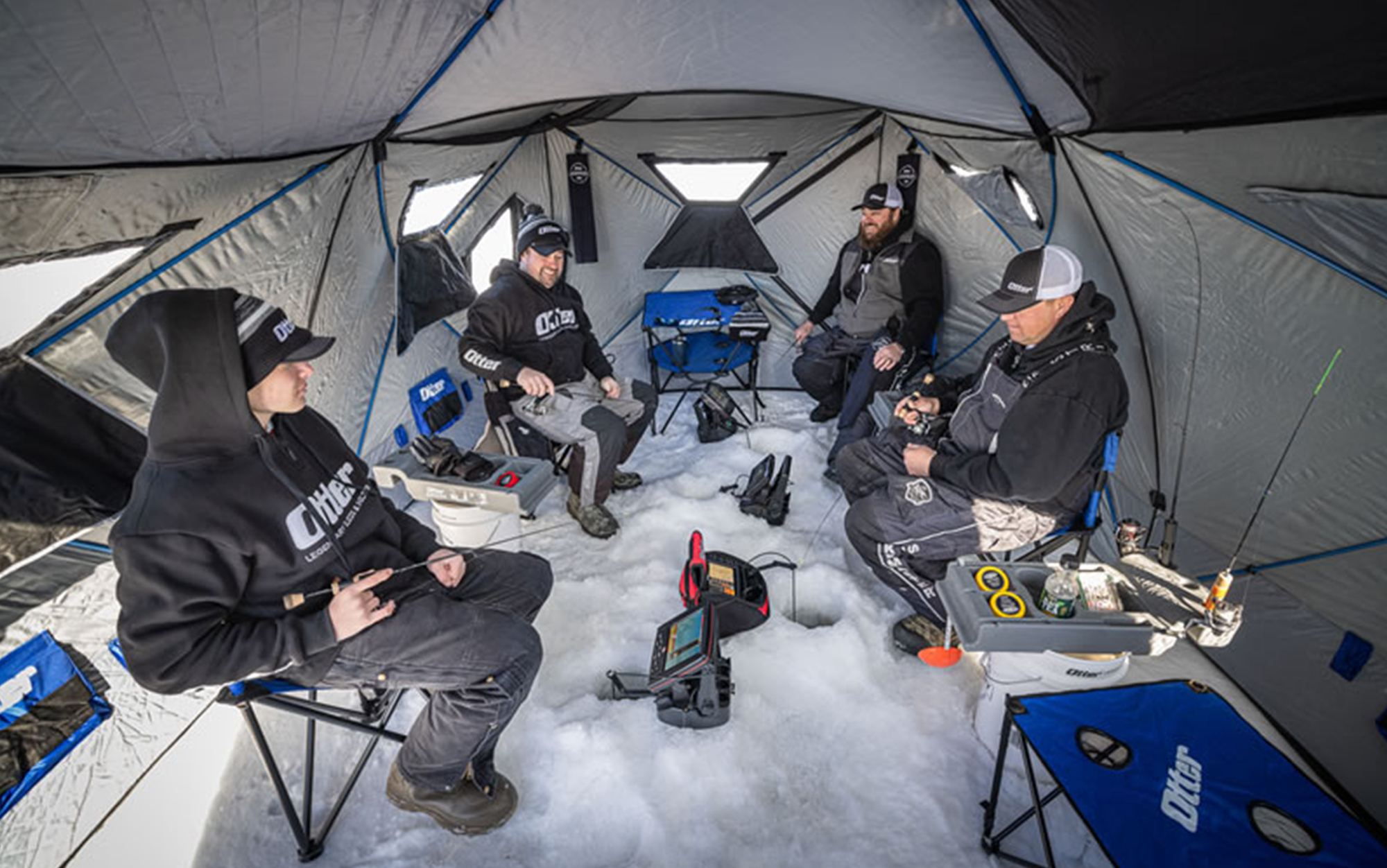
For this ice season, I used clamp-on rattle reels in the shack corners. To keep the massive area toasty, I ran an 18,000 BTU Heat Hog propane heater with low-oxygen shut-off but also keep two carbon monoxide detectors on at all times. I run the heater on low to bring the ambient temperature inside the hub to between 55 and 60 degrees, although you could easily raise the temp even higher.
When I first started ice camping, I used one side of the hub for a kitchen, but have since decided to use a small hub for just cooking, leaving more room for cots and holes to fish—and less smell and carbon monoxide build-up. I also use a separate shelter as an outhouse. The lightweight Ice Runner 1-man flip-over Escape makes a very convenient (and inexpensive) outhouse placed behind the larger hub. Outfitted with a sturdy Stansport portable toilet (300-pound person capacity), we were good to go. Literally.
There are a few issues with this otherwise excellent ice shelter. The Otter Vortex Monster Lodge only comes with one packing strap. While the strap is great with its high compression quick-release buckle, I ordered two more sets of two straps each because you need to cinch the shack down in four to five spots to get it into the bag. I also would prefer two full-size doors instead of one plus a partial door. Lastly, I had a door frame pole splinter, which required some Gorilla tape.
Lightest One-Person Flip-Over: Ice Runner Ice House Escape
Key Features
- Weight: 38 pounds including sled
- 10.4 square feet of fishable space
- 600 denier quilted, insulated fabric
- Black fabric for solar heat retention
- Smart, rear-entry door
- $329.99 MSRP
Pros
- Affordable
- Long front windows for monitoring tip-ups
- Ceiling skylight window
- Sled/house travel cover included
Cons
- No built-in chair
- Smaller diameter, push-button support poles
There are a lot of new anglers ice fishing solo, and many don’t own an ATV, snowmobile, or have enough ice to support full-size vehicles. Especially on metropolitan fisheries, a lot of anglers still hump their gear by hand to fishable spots. This necessitates a lightweight ice fishing shelter like the Ice Runner Ice House Escape.
I really appreciate the rear door versus a front or side door. This prevents tripping over gear or stepping in a hole: smart design. One thing I immediately noticed in testing the Ice House Escape was the lack of a built-in chair, presumably to cut weight and keep the cost down. Personally, I didn’t find this to be a big deal. I simply brought my favorite collapsible folding chair and set it up inside the sled.
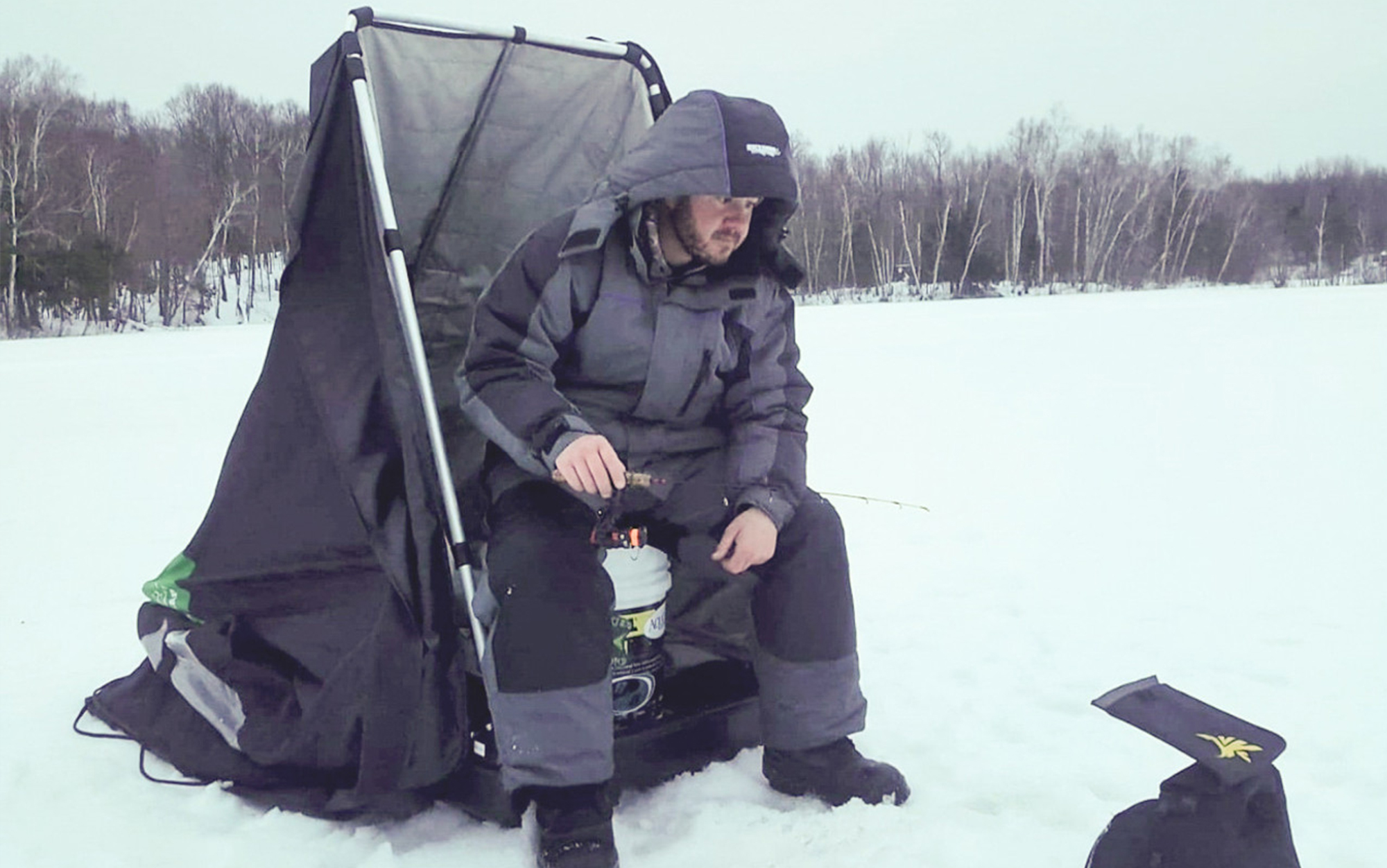
The house is also extremely warm thanks to the added heat from the black fabric. You can run your stove on low or not at all on warmer days. The Escape features 10.4 feet of fishable space and a sled (with included cover) that holds necessary ice fishing gear. It’s definitely my top choice for fishing on foot or hole hopping when weight is a huge priority. A lot of competitive ice panfish anglers have turned to this house to get out of the elements but still maintain the mobility they need to hole-hop and stay on fish.
The house features long, vertical windows in the front for monitoring tip-ups and a skylight window, a design feature most portable fish houses lack. As I mentioned earlier, this shack makes a great affordable outhouse for use with larger hubs or hard houses.
The shack’s push-button pole system needs some lubrication for easier set-up and tear-down. I simply sprayed the joints and buttons with PAM canola oil spray, which I also use to keep my rod eyelets free of ice when fishing outside.
Roomiest One-Person Flip-Over: Eskimo Wide 1 XR Thermal
Key Features
- Assembled Dimensions: 102 x 58 x 64.5 inches
- Ceiling Height: 64.5 inches
- Sled Size: 53 x 36 x 9 inches
- Collapsed Size: 57 x 36 x 18 inches
- Weight: 38 pounds including sled
- 17.5 square feet of fishable space
- Insulated fabric
- MSRP: $599.99
Pros
- Gray interior for more ambient light
- Rugged and comfortable rotating chair
- Plenty of room for three holes (jigging rod, deadstick, and forward-facing sonar)
Cons
- Ceiling height is a bit low
For years I ran the Frabill Ice Hunter 115, which was designed by veteran ice guide and ice fishing product innovator Brian “Bro” Brosdahl and offered approximately 12 square feet of fishable space. Super warm and lightweight, this shack—and some of Clam’s—were the standards for run and gun solo ice fishing.
As of this winter, I’m now in love with the Eskimo Wide 1 XR Thermal 1-person flip shelter, which offers tons of headroom, elbow room, and square footage. A single bottom pole expands the framework at the push of a button to accommodate a massive 17.5 square feet of fishable area—enough space for three holes—one for forward-facing sonar, one for a jigging rod, and one for a deadstick or ceiling-pole-mounted rattle reel.
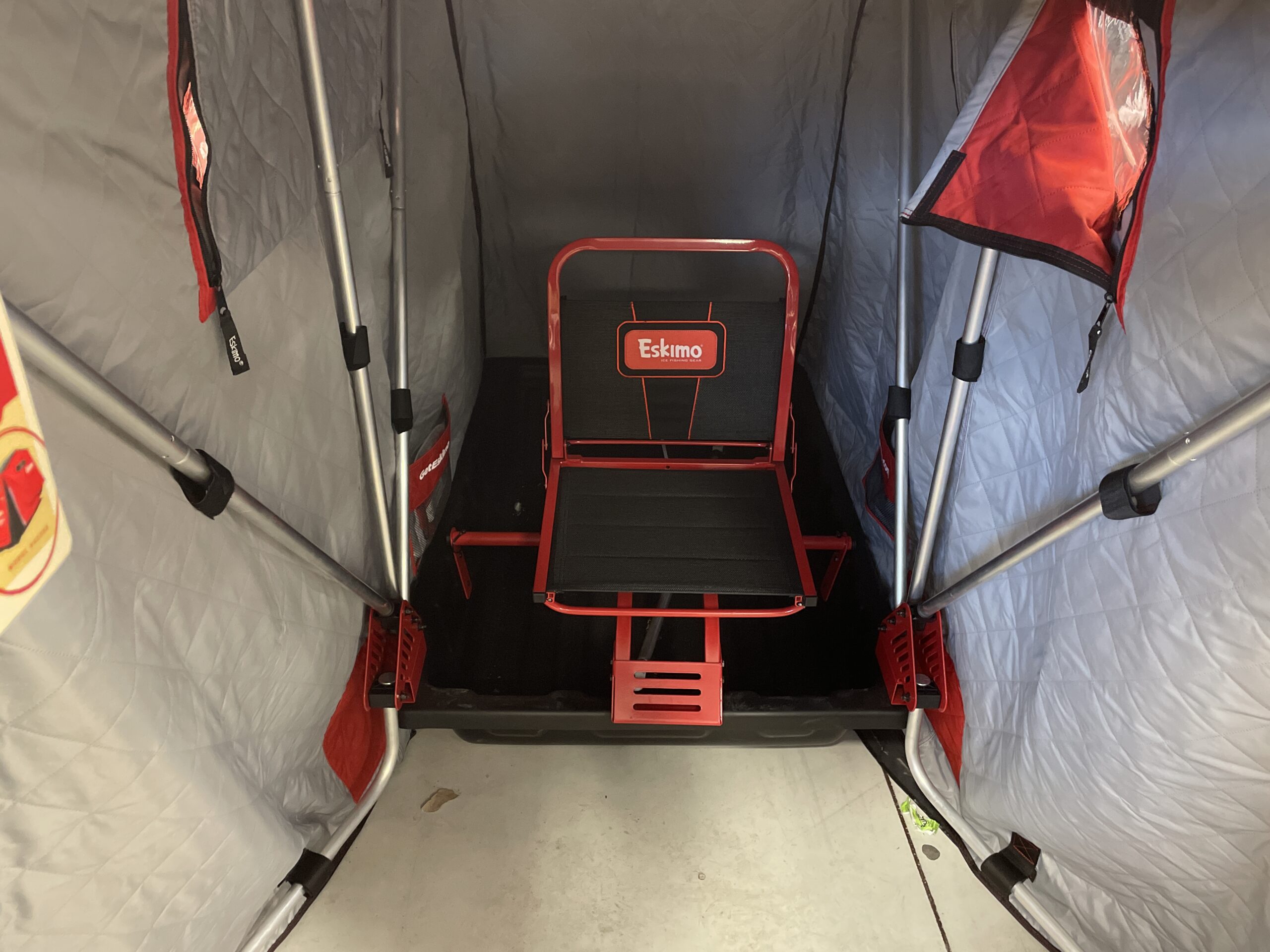
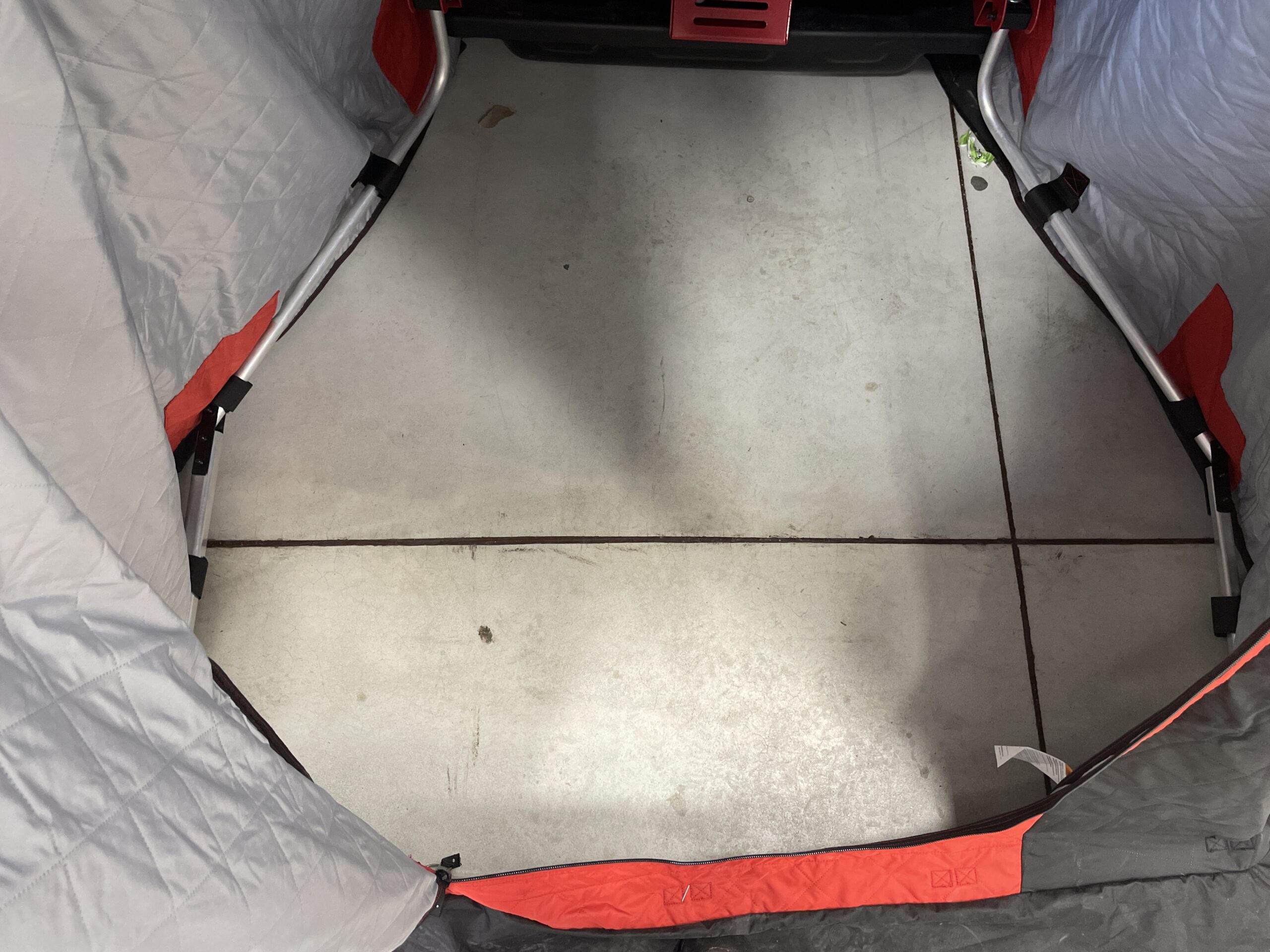
In terms of warmth, the shack tested great with a 9,000 BTU Heat Hog heater on low. I like the gray interior, which enhances ambient light and makes tying on jigs easier. In terms of comfort, the mesh and steel frame seat is easy on my body, minimizing back and leg fatigue and the design doesn’t add a lot of weight to the overall shack.
I was impressed with the poles, which seemed sturdier and wider in diameter than many solo portable houses. It performed great in the wind.
The only cons involve ceiling height. I wish the Eskimo Wide 1 XR Thermal had the ceiling height of the Jason Mitchell-designed Legend XT 1-Man Flip-Over. Mitchell’s flip-over has a 73 inch ceiling to accommodate hook sets with longer rods. However, the Legend XT is 22 pounds heavier, has a foot-and-a-half less of fishable space, and retails for $200 more than the Eskimo XR-1 Wide.
At the end of the day, the best one-person flip-over ice fishing shelter based on weight, cost, and fishable space is the XR-1. If you’re pulling it out by hand or harness, you can’t beat fishing with multiple lines and forward-facing sonar. For fishing by snowmobile, ATV, or truck, the Jason Mitchell Legend XT 1-Man Flip-Over is ideal, especially if fishing large walleyes or lake trout with longer rods.
Lightest Two-Person Flip-Over: Ice Runner Ice House Explorer
Key Features
- Ceiling Height: 74 inches
- Weight: 49 pounds, sled and cover included
- 18.2 square feet of fishable space
- 600 denier quilted, insulated fabric
- Black fabric for solar heat retention
- Rear-entry door
- MSRP: $429.99 MSRP
Pros
- Affordable
- Long front windows for monitoring tip-ups
- Ceiling skylight window
- Sled/house travel cover included
Cons
- No built-in chairs
- Smaller diameter support poles
If weight is your primary concern in choosing a thermal two-person flip-over portable fishhouse, then the Ice Runner Ice House Explorer is probably a good fit with an easily justifiable price tag.
Besides fishing two anglers comfortably, the Ice Runner Explorer makes a great 1-man if you’re looking for more room and fishing additional lines. Like its kid brother, the 1-man Ice Runner Escape, this shelter features a rear-entry door, which means no tripping over electronics, set lines, or portable propane heater.
This shack tested great on a Northern Minnesota lake in a -30 degree windchill. I hand-pulled it out with the auger, my tackle, bait, and heater in the provided sled. Even through foot-deep snow, with some 6 inches or more of slush trapped underneath, I had no issues dragging the 49-pound Ice Runner Ice House Explorer out to my spot. My buddy “Big Mike” and I fished comfortably in it, which is surprising considering we’re both over 6 feet tall and similarly wide individuals. Once back to the garage, I built a floor out of the same 1-inch foam exercise mats I use for my camping hubs. In terms of a lightweight, two-man shelter, with a reasonable price tag, the Ice Runner Explorer is it.
Like the other Ice Runner 1-man Escape, the poles require some lubrication for easier set-up and tear down.
Most Durable: Jason Mitchell XT Thermal
Key Features
- Assembled Dimensions: 93 x 72 x 79 inches
- Ceiling Height: 79 inches
- Collapsed Size: 72 x 40 x 26 inches
- Weight: 125 pounds
- 26 square feet of fishable space
- 900 denier with 90 grams of insulation per meter
- 1 ¼-inch pole system with Rapid Pole Slide Extreme (RPXS) system
- Four-pole spreader kit
- Battery bracket
- Large dimmable light stick entry
- Included bait bucket and bracket
- Two 4-position rod holders
- Three year warranty
- 51 x 14-inch overhead mesh storage area
- MSRP: $1,249.99
Pros
- Super tough and warm
- Roomy side-doors
- USA-made sled
- Thick-diameter poles
- Gray co-extruded plastic tub/sled makes locating items easier
- Deep and wide tub/sled makes travel through deep snow and slush easier
- Two comfortable, padded, and removable seats that adjust front to back and left to right
Cons
- Heavy
- A bit difficult to pull by hand or back harness through deep snow
- Should include Clam X-Series runners
There is a hardcore group of ice anglers across the country who fish the most harsh and demanding situations imaginable. From the Great Lakes through the Canadian provinces these anglers put equipment through the hell and demand the most rugged ice fishing products made.
Jason Mitchell, a Dakotas-resident, former longtime guide, and JMO Outdoors host, designed the most-rugged and tricked-out two-man flip-over shack I’ve ever fished out of.
The Jason Mitchell XT Thermal flip-over ice fishing shelter is built like a tank. The deluxe flip-over includes two very comfortable, removable seats that adjust both front to back and left to right, which I found to be a great feature that is lacking in most portable flip-over shelters. The sled is deep and wide, making pulling through slush or deep snow behind a machine much easier than standard designs.
The Jason Mitchell XT Thermal Flip-Over is also packed with common-sense ice fishing accessories like a built-in bait bucket, overhead mesh storage, under-seat hammock-style storage, rod holders, battery bracket, and dimmable lighting. The center height is also nearly 6.5 feet for easy entry, and allowed me to fully stand-up and stretch, thus avoiding leg cramps on all-day sits. The ceiling height also made hooksets with longer rods easier. The 26 feet of fishable space easily accommodated numerous holes for jigging and deadsticks, as well as the use of a front-facing sonar unit.
There is also a three-year, no-questions-asked warranty. But it all comes with a price tag of $1,249.99. Still, for ice anglers who are serious about their trips, and run snowmobiles or other on-ice vehicles on hard water, this is the shack that’s going to get the job done and keep you comfortable in the worst conditions.
How to Choose A Portable Ice Fishing Shelter

A basic ice fishing shelter should have a waterproof finish, insulated sides and ceiling, and provide sufficient ventilation to remain comfortable and safe on the inside. I don’t think uninsulated shelters are worth the investment. Non-insulated shelters may be cheaper upfront but cost more in the long run when you consider propane usage. When you look at the difference in pricing, it’s better to go with an insulated hub or flip-over shack.
Pop-Up/Hub Shelters
Pop-up ice fishing shelters are often referred to as hub shelters. These are generally lightweight, portable shelters that fold down into a compact package and fit into a convenient transport and storage bag. A framework of poles throughout the hub provides rigidity to the structure. Once inside, anglers enjoy access to considerably more fishable area than might be available in a flip-over shack.
Flip-Over Shacks
While pop-up ice fishing shelters seem to be taking over the marketplace, there’s still a time and place for flip-over shacks on the ice. With lineage back to Dave Genz’ garage and the original “Fish Trap” flip-over in 1980, today’s flip-overs still share design features similar to Genz’ game-changing invention—but they’ve also evolved over the past four-plus decades.
There are lightweight shacks for simply getting out of the elements and pulling by hand onto metropolitan fisheries or hard-to-reach waters only accessible by foot. You can also buy deluxe models with bench-style seating to accommodate up to four anglers and that are built to withstand the rigors of rough ice.
Insulation
The best ice fishing shelters have a durable, waterproof exterior to keep the cold, snow, and sleet at bay. Most often 600 to 900 denier fabric is used to form a quilted, insulated interior. This count simply refers to the thickness of the individual fibers that make up the threads of the fabric. Usually, the higher count the better.
Heating Your Ice Fishing Shelter
Avoid using “sunflower” heaters inside your ice fishing shelter. They produce excess carbon monoxide and can easily burn fabrics. While they throw off a lot of heat, they’re not meant for small, inside quarters.
Buddy-style heaters are standard, manufactured by Mr. Heater, Dewalt, Flame King, and others. I’ve been using both the 9,000 and 18,000 BTU models from Heat Hog which feature a better-designed pilot light guard to prevent blow-outs from anglers entering and exiting shack doors. Heat Hog heaters also feature an upward-rotating heating element that keeps heat off the ice, thus reducing water and slush build-up on the ground inside.
One-pound propane canisters typically fetch between five and eight dollars. My advice? Invest in a 5-gallon, 10-gallon, and 20-gallon tank to run your portable propane heater. Use whichever matches the amount of time you’ll be on the ice. You’ll not only save on propane expenses by having them filled locally off a bulk tank, you won’t worry about running out of fuel. And if you’re ice camping for more than a day, bring two 20-pounders. Take it from me, there’s nothing worse than running out of propane in sub-zero temperatures, especially in the middle of the night.
What to Look for in an Ice Fishing Shelter
A quality ice fishing shelter also has abundant ventilation to allow moisture to escape and allow anglers to safely use portable propane-powered heaters. On the outside, skirting that extends away from the shelter allows anglers to bank snow along the sides, while robust anchoring systems prevent the shelter from being carried away by a wind gust. Abundant creature comforts on the interior, including built-in storage netting, add-on coat hangers, rod holders, lights, and even insulated floor options make it easy to fish while staying warm and dry.
Look for windows on all four sides of the shelter to provide ample natural light and help you monitor tip-ups while inside. A model that should be noted that was designed specifically for monitoring tip-ups or auto-setting devices is the Clam X-500 Lookout Hub, which features three large windows per wall. If I had a “best of” category for shacks to monitor tip-ups, tip-downs, and auto-setters (where legal), the Clam X-500 would be it.
Your basic portable ice fishing house should also come with a storage bag and the tools needed to anchor it to the ice. I recommend purchasing an anchor bit that fits into the chuck of various battery-powered drills. All manufacturers have slightly different anchor designs, so look for a universal ice anchor drill bit, or the bit for the brand house you choose, like this model from Otter Outdoors. You can also go the route of buying extra ice anchors that already have a bit on them like these from Trophy Outdoors, a very smart, universal design.
And here’s another tip: Like the old timers’ trick to keep fishing rod eyelets free of ice in sub-zero conditions, spray your ice anchors down with inexpensive and readily-available PAM cooking spray. They’ll go into the ice much easier.
FAQs
Several prominent manufacturers based in the Ice Belt have a long history of manufacturing ice fishing shelters. Clam, Eskimo, Jason Mitchell Designs by Clam, Otter Outdoors, and Ice Runner all produce ice fishing shelters packed with the feature-sets and durability today’s ice anglers demand.
Frabill, too, used to be a leader in portable fish house design and manufacturing but no longer markets hubs, flip-overs, or ice fishing apparel. If you can find a used Frabill portable fish house, know that many models were very well-constructed and offered some great features.
An ice fishing shelter can provide many seasons of use and enjoyment. To get the most years out of your shelter, dry it completely after every trip to prevent mold and mildew. When using a portable heat source inside your shelter, keep it away from the walls to prevent burns and holes. During the summer, keep your ice fishing shelter stored off the ground to reduce the chances that mice might move in and chew the shelter to bits. Adding a few Bounce dryer sheets to your packed-up hub or flip-over will further deter mice from doing damage.
Key features to consider when buying an ice fishing shelter include enough fishable space, windows to let in light and allow you to monitor tip-ups, insulation, and a weight that you can transport easily. Many ice fishing shelters offer an array of accessories including rod holders, rattle reels, interior lights, coat hangers, and storage areas that make fishing inside a shelter more convenient. u0022Tricking outu0022 your hub or flip-over shelter with add-on accessories is definitely part of the fun.
Final Thoughts
An ice fishing shelter is a necessity if you plan to fish on cold, windy, or snowy days. The warm and dry fishing area provided by a contemporary ice fishing shelter will let you fish longer and in comfort. If you’re in the market for a shelter, checkout my top picks for the best ice fishing shelters and weight the features of the products with your angling needs.
- Best Overall: Eskimo Outbreak 450XD
- Best Value: Eskimo QuickFish 3i
- Best for Two People: Otter Outdoors Vortex Pro Cabin
- Best Four to Six People: CLAM X-600 Thermal Hub
- Best for Ice Camping: Otter Outdoors Vortex Pro Monster Lodge
- Best Lightweight One-Person Flip-Over: Ice Runner Ice House Escape
- Most Roomy One-Person Flip-Over: Eskimo Wide 1 XR Thermal
- Lightest Two-Person Flip-Over Thermal Shelter: Ice Runner Ice House Explorer
- Most Tricked-Out Two-Person Thermal Flip-Over: Jason Mitchell XT Thermal
